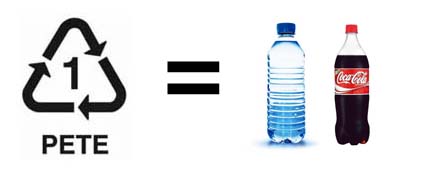Everyone produces about 2 kilos of garbage each day. Imagine having to wear that much garbage everyday!
It’s easy to consume and toss out garbage and not think about it again, but it affects us in almost everyway. The garbage will end up in landfill where it will produce greenhouse gases, contributing to our climate change woes, as well as contaminating the fish we eat.
The best solution is to avoid those plastics and disposables whenever you can. To make this achievable, bringing your own reusables will definitely reduce unnecessary waste production.
Although, it is easier to start with habits that are easier to pick up and maintain, and that is being selective with the types of plastic you use. Regardless of whether you’re concerned about recycling or not, certain plastics can be toxic to your health. Such as BPA, a highly toxic chemical, found in plastic is linked to obesity, cancer, and endocrine problems in humans.
By knowing the 7 different types of plastic, you’ll know which ones are safe to use. The plastic types are usually printed on the top, side, or bottom, with a number inside a recycling symbol.Those numbers identify the type of plastic, rating its health to humans and whether it is eco-friendly.
Plastic 1: Polyethylene terephtalate (PETE or PET)

It is usually transparent, most commonly found in disposable soda and water bottles. This plastic is safe and is recyclable by most recycling plants. However, the plastic surface enables bacteria to cultivate so it’s not recommended to reuse it.
Plastic 2: High-density polyethylene (HDPE)

Typically found in milk jugs, detergent bottles, juice bottles, and toiletries. It is widely accepted by most recycling plants and is safe to use continuously.
Plastic 3: Polyvinyl chloride (PVC)

Usually found in food wraps, cooking oil bottles, and common plumbing pipes. It is not safe to cook food near it as it can leak chemicals. This includes microwaving some cling wraps. Unless the label reads microwave-safe, it is generally not safe to microwave your food with it.
Plastic 4: Low-density polyethylene (LDPE)

Typically used to make grocery bags, food wraps, squeezable bottles, and bread bags. It is safe to use but it’s not recyclable.
Plastic 5: Polyproplene

Usually found in medicine bottles, ketchup, syrup bottles, and straws. The plastic is safe and is accepted by many recycling plants.
Plastic 6: Polystyrene, more commonly known as Styrofoam

Most commonly found in disposable plates, trays, and cups. It is also commonly found in yoghurt cups but some are made with plastic type 5. It is recommended to stay far away from this type of plastic because many studies and heavy evidence have found that its low melting point can leak toxic chemicals into your food. It is also extremely difficult to recycle and most recycling plants don’t accept them.
Plastic 7: everything else that was invented after 1987

Use this plastic at your own risk. Lots of unknown chemicals are in this plastic, and some more well-known ones likes the highly toxic BPA. These are used to make baby and water bottles, sports equipment, medical and dental devices, and even iPhones. It’s best to stay far away from this plastic as it is both harmful to humans and it’s non-recyclable.
Too long, didn’t read
Plastics 2, 4, and 5 are the safest out of all the others, but it’s safest to forgo plastic entirely and use glass options whenever you can.
O.L.
For the latest updates, follow our blog, Facebook, and Twitter.
Sign our pledge below to reduce waste production!

This blog is great to supplement my recycling campaign, which I previously also talked about similar content (https://binaware.wordpress.com/2016/09/28/7-common-plastic-symbols-we-should-be-aware-of/) like yours~
Plastics have such important role in our daily practices these days and we all understand how hard to prohibit using them. What we need to do is engage more public and let them be more aware of the good and bad plastics, making good use of the good ones and away from the bad ones. Recycle as many as plastics as we can. We both made a good summary that 2,4,5 are the relevant safe plastics that are more preferred to be used. Feel free to visit my blog and would love to have further discussion with you 😀
LikeLike
A fantastic summary! Would you mind if I shared your post on my blog?
LikeLiked by 1 person
Go for it 🙂
LikeLiked by 1 person
wow!! did not understand signs before!! thanks for your information
LikeLiked by 1 person
Glad to help you out!
LikeLiked by 1 person
I currently have a blue Asics sports drinking bottle. What category would you put that in and is it also safe to use?
Sometimes when I drink water out of it, I can taste plastic. Is that normal or will that cause me cancer?
LikeLiked by 1 person
You would need to check which recycling symbol is on your water bottle. 2,4 and 5 are usually the safest, although it’s best to ditch plastic entirely and switch to stainless steel or glass bottles. Regardless, I suggest you should find a replacement bottle asap because you shouldn’t be able to taste plastic when drinking water.
LikeLike